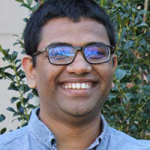
Learning System Dynamics to Support Policy Research, No Advanced Math Required
For students exploring policy research, skills in systems thinking and computer modeling can be a valuable asset. However, many modeling tools are only accessible to those with advanced mathematical backgrounds.
The Modeling Health & Environment Graduate Working Group, organized by Shashika Bandara (M.Sc. in Global Health) and Varun Mallampalli (Ph.D. in Civil & Environmental Engineering), provided an opportunity for Duke students from multiple disciplines to learn about system dynamics modeling and build complex models relevant to their research.
System dynamics is a modeling method that allows the user to create complex graphic representations of systems and identify policy intervention points.
Bandara and Mallampalli received a Duke Support for Interdisciplinary Graduate Networks (D-SIGN) grant from the Office of the Vice Provost for Interdisciplinary Studies for 2017-2018. Their faculty sponsors were Kevin Schulman and Mark Borsuk.
Here are excerpts from their year-end report.
We had a working group consisting mainly of engineering, global health, and public policy students. Our strategy was focused around exposing graduate students in global health and public policy to system dynamics modeling and exposing engineering students to the world of practical policymaking.
We used STELLA software that allows students to graphically build complex models. We chose this software as all students do not have the advanced mathematical background required by many modeling software.
As a Ph.D. student in engineering, I was able to improve my teaching skills and collaborative skills by being part of this working group. Being exposed to issues related to global health and the potential avenues for collaborative research was a great learning experience for me.
–Varun Mallampalli
We provided basic training on STELLA software for graduate students, opportunities to learn more about the use of modeling in research environments, and self-learning tools and relevant lectures from the project on an online platform. We also created course material based on the working group sessions.
The first session centered around an interactive exercise where students actively engaged in building a model to ward off a hypothetical flu epidemic at Duke. Students responded by saying, “I would take a course on this” and “This was very useful.” The interactive environment meant students exchanged ideas and identified different ways to address the flu epidemic at Duke. Below is a diagram of the system students built over a two-hour interactive learning session.


In the second and third sessions we invited guest lecturers from Duke to outline the practical aspects of policymaking and modeling. Professors Mark Borsuk and Kevin Schulman talked about practical use of modeling in the context of environmental and health systems respectively. Professor Gavin Yamey from the Duke Global Health Institute engaged students on evidence-based policymaking and improving writing skills.
The fourth session was an interactive learning session around modeling predator-prey systems in the environmental sciences. The fifth session was a webinar with Professor Georgia Mavrommati, Assistant Professor of Ecological Economics at the University of Massachusetts, Boston. She spoke to students about sustainability in coupled human natural systems, specifically looking at coastal and lake systems and their ecological health as a consequence of human interaction.
As a global health master’s student, it was a great opportunity to consider how I can use modeling as a powerful policy advocacy tool. As a group, we benefited not only by the technical modeling-related knowledge sharing but also by the advice given by guest lecturers on communication, research, and careers. It was rewarding that even students outside the working group expressed interest in learning modeling due to the guest lectures. This is why we hope to make the learning tools available online for all students.
–Shashika Bandara
Based on the feedback from the working group and requests we received from undergraduate students, we decided to create an online resource for students to learn system dynamics modeling. Thus, our current steps include building a series of instructional videos. We will make these videos, guest lectures and other resource material available on a website dedicated to this project. We also aim to develop course materials integrating all our lessons learned during the five sessions. We hope this course will serve as a guide to students to engage more deeply with this subject.
As two graduate students from different fields, this project provided us with the opportunity to understand potential collaborative opportunities between global health and engineering. Also, it gave us the opportunity to reach across and beyond the campus to gain expert opinions on the use of modeling.
About D-SIGN
This internal funding mechanism from the Office of the Vice Provost for Interdisciplinary Studies encourages graduate students to explore beyond disciplinary lines, both in research and coursework. The goal is to enable graduate students to build or extend their networks and to integrate collaborative, cross-school experiences into their programs, thereby increasing the number of individuals whose graduate training reflects Duke’s commitment to interdisciplinarity and knowledge in the service of society.
- See who else received D-SIGN grants in 2017-2018.
- Look ahead to next year’s D-SIGN projects.
- Browse D-SIGN posts.
Caption for main image: Professor Mavrommati’s webinar; Varun Mallampalli; diagram of students’ model to ward off a hypothetical flu epidemic; Professor Yamey’s guest lecture on evidence-based policymaking; Shashika Bandara
